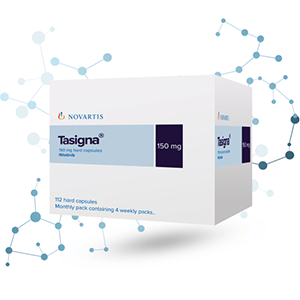Tasigna Overview
 Tasigna (nilotinib) is a blood cancer drug that treats Philadelphia chromosome-positive chronic myeloid leukemia (Ph+ CML). In fact, Tasigna sales exceeded $1 billion in 2012 and keep rising. Learn more about this new leukemia drug’s risks and benefits in our Tasigna overview below.
Tasigna (nilotinib) is a blood cancer drug that treats Philadelphia chromosome-positive chronic myeloid leukemia (Ph+ CML). In fact, Tasigna sales exceeded $1 billion in 2012 and keep rising. Learn more about this new leukemia drug’s risks and benefits in our Tasigna overview below.
Tasigna belongs to a drug class known as tyrosine kinase inhibitors (TKIs). Tasigna specifically targets the BCR-ABL tyrosine kinase enzyme — a unique protein spurring blood cancer cell growth. Unfortunately, our Tasigna overview also reveals the drug’s potentially life-threatening side effects. Several clinical studies show irreversible Tasigna damage that can last longer than leukemia. Because of these harmful effects, people are filing lawsuits against Novartis International AG, the company that manufactures and markets Tasigna.
Tasigna Overview: How Does It Work?
Tasigna blocks the patient’s body from producing a specific tyrosine kinase protein called BCR-ABL. This BCR-ABL protein houses the Philadelphia chromosome which specifically causes chronic myeloid leukemia (CML). In fact, 95 in 100 people with CML also have the Philadelphia chromosome. And since CML accounts for 15% of all adult leukemia cases, Tasigna’s the most popular and obvious treatment option. Tasigna is a red pill patients take twice daily in 12-hour intervals. Doctors conduct blood tests before as well as after each treatment to check blood cell count, liver and kidney functions.
Tasigna Overview: Heart Risks Associated With Second-Generation TKIs
All drugs cause some side effects, but studies show Tasigna causes more vascular adverse events (VAE) than other new-generation TKIs. Specifically, Tasigna can cause severe and rapid-onset atherosclerosis (also known as coronary artery disease). In many cases, these cardiovascular events and side effects may outweigh the drug’s benefits.
Atheroslerosis begins when high blood pressure, smoking or high cholesterol damages the endothelium (the cell layer that lines arteries). This cell layer damage causes plaque to form on the arterial wall, blocking adequate blood flow throughout the body. Over time, coronary artery disease can damage your heart and increases your risk for stroke and poor circulation issues, including:
- Heart attack
- Leg pain/numbness
- Limb amputations
- Blood clots
Multiple clinical studies show increased VAE-related incident rates in Tasigna patients. This concerns medical professionals, since VAEs (particularly arterial) require long-term monitoring and vigilance. Therefore, oncologists should screen CML patients for preexisting vascular conditions and other risk factors before prescribing Tasigna. Otherwise, these patients may experience avoidable life-threatening Tasigna complications.
Tasigna Overview: Canadians Warned About Heart Risks, But Not Americans
Unfortunately, Tasigna’s most serious potential side effects still aren’t widely known to American consumers. In April 2013, Health Canada issued a drug safety warning after clinical trials found Tasigna increased cardiovascular adverse events. However, drug manufacturer Novartis didn’t issue a similar warning to American consumers about Tasigna’s life-threatening heart damage risks.
Since Tasigna patients weren’t warned about the drug’s potential heart dangers, several lawsuits are now underway. Plaintiffs allege Novartis failed to warn consumers and U.S. healthcare providers about Tasigna’s potentially life-threatening side effects, including coronary artery disease. Many Tasigna plaintiffs also say their persistent, life-threatening heart problems directly resulted from Novartis’ negligence.
Tasigna Overview: Could Clinical Trials Have Prevented Current Lawsuits?
The FDA approved Tasigna in 2007 for treating CML, then again in 2010 for chronic-phase Ph+ CML. But because Novartis didn’t conduct extensive premarket clinical trials for Tasigna patient safety, consumers weren’t warned about increased atherosclerosis risks. An American Journal of Hemotology 2011 nolotinib study found 33% of participants experienced peripheral artery disease and sudden death. In March 2016, Kristi Lauris filed the first lawsuit against Novartis after her father, Dainis Lauris, died while taking Tasigna.
California resident Lauris suffered a major stroke and died while taking Tasigna in March 2014. Lauris’ lawsuit claims that Novartis intentionally failed to warn American doctors and consumers about Tasigna’s potentially fatal cardiovascular side effects. “Novartis did not send advisories to the United States public or to United States doctors,” the lawsuit claims. “Nor did Novartis properly warn of the atherosclerosis-related risks on the United States Tasigna label. Novartis’s failure to warn United States doctors and patients of the serious risks of developing atherosclerosis-related conditions associated with Tasigna was intentional, and part of an aggressive marketing strategy to sell Tasigna over competing TKI drugs.”
Tasigna Overview: Current Settlement Outlook
While the Lauris’ case is pending, Novartis already settled one U.S. Justice Department Tasigna lawsuit in 2015. Novartis paid $390 million to settle illegal marketing and kickback scheme allegations involving Tasigna, Exjade, Myfortic, Gleevec and TOBI promotions. Novartis AG hasn’t yet reached any Tasigna lawsuit settlements for claims due to atherosclerosis. However, individual claims can help hold pharmaceutical companies like Novartis legally responsible for their actions and get the justice you deserve.
Check eligibility for compensation.
If you or a loved one experienced heart failure, coronary artery disease or strokes while taking Tasigna, you may be entitled to compensation from the manufacturer. Request your free case evaluation now to see if you may qualify.




